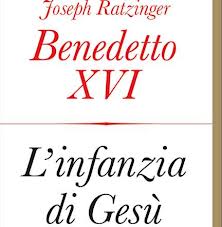 “L’infanzia di Gesu” (“The Infancy Narratives”), the third volume of Benedict XVI’s trilogy dedicated to Jesus of Nazareth, will be available in Italian bookshops tomorrow, 21 November. The book, published in Italy by Rizzoli and the Vatican Publishing House, will be released simultaneously in several languages (Italian, German, Croatian, French, English, Polish, Portuguese and Spanish) and in fifty countries; the worldwide print run of the first edition will be more than a million copies. In the coming months, the book will be translated into twenty languages for publication in seventy-two countries.
“L’infanzia di Gesu” (“The Infancy Narratives”), the third volume of Benedict XVI’s trilogy dedicated to Jesus of Nazareth, will be available in Italian bookshops tomorrow, 21 November. The book, published in Italy by Rizzoli and the Vatican Publishing House, will be released simultaneously in several languages (Italian, German, Croatian, French, English, Polish, Portuguese and Spanish) and in fifty countries; the worldwide print run of the first edition will be more than a million copies. In the coming months, the book will be translated into twenty languages for publication in seventy-two countries.
Tuesday morning, in the Vatican’s Sala Pio X, the book was presented to the press. The speakers were Cardinal Gianfranco Ravasi, president of the Pontifical Council for Culture; Maria Clara Bingemer, professor of theology at the Pontifical Catholic University of Rio de Janeiro; Fr. Giuseppe Costa, director of the Vatican Publishing House; Paolo Mieli, president of Rizzoli (RCS) Publications, and Fr. Federico Lombardi S.J., director of the Holy See Press Office.
The book, defined by its author as a “small antechamber” to the trilogy on Jesus of Nazareth, is 176 pages long and comprises four chapters, an Epilogue and a brief Foreword. A summary of the book is given below:
“The first chapter is dedicated to the genealogies of the Saviour in the Gospels of Matthew and Luke, which are very different, although both have the same theological and symbolic meaning: the placing of Jesus in history and his true origin as a new beginning of world history.
“The theme of chapter two is the annunciation of the birth of John the Baptist and that of Jesus. Rereading the dialogue between Mary and the Archangel Gabriel in the Gospel of Luke, Joseph Ratzinger explains that, through a woman, God ‘seeks to enter the world anew’. In order to liberate man from sin, he writes, quoting Bernard of Clairvaux, God needs ‘free obedience’ to his will. ‘In creating freedom, he made himself in a certain sense dependent upon man. His power is tied to the unenforceable yes of a human being’. Thus, only thanks to Mary’s assent can the history of salvation begin.
“Chapter three is centred on the event in Bethlehem and the historical context of the birth of Jesus, the Roman Empire under Augustus, which extends from East to West and whose universal dimension allows for the entry into the world of ‘a universal Saviour’; ‘it is indeed the fullness of time’. The single elements of the story of the birth are dense with meaning: the poverty in which ‘he who is truly the first-born of all that is’ chooses to reveal himself, and therefore ‘the cosmic glory’ that envelopes the manger; God’s special love for the poor, which manifests itself in the annunciation to the shepherds; and the words of the Gloria, whose translation is controversial.
“The fourth chapter is dedicated to the three Magi, who saw the star of the ‘King of the Jews’ and who had come to adore the child, and to the flight into Egypt. Here the figures of the ‘magoi’, reconstructed through a rich range of historical, linguistic and scientific information, are outlined as a fascinating emblem of the inner unrest and search for truth of the human spirit.
“Finally, the Epilogue, with the story – according to the Gospel of Luke – of the last episode in the childhood of Jesus, the last account we have of him before the beginning of his public ministry with his baptism in the Jordan. It is the episode of the three days during the Passover pilgrimage to the Temple in Jerusalem, in which twelve-year-old Jesus leaves Mary and Joseph and stays in the Temple to discuss with the rabbis. Jesus, who was growing ‘in wisdom and in stature, and in favour with God and man’, manifests himself in his nature as true God and, at the same time, true man, who ‘thought and learned in human fashion'”.





